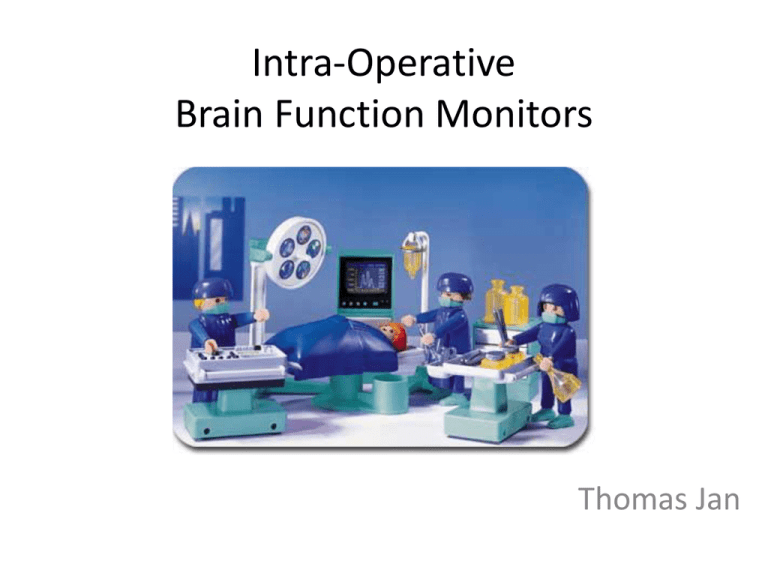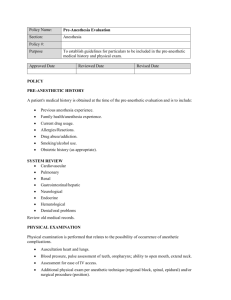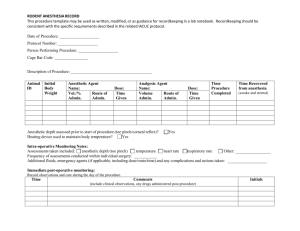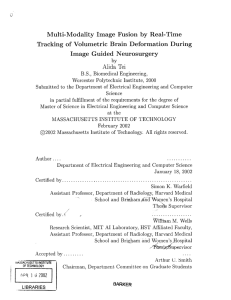Awareness Monitors
advertisement

Intra-Operative Brain Function Monitors Thomas Jan Goals of General Anesthesia • • • • • Anxiolysis Analgesia Hypnosis Muscle Relaxation Suppression of Somatic/Autonomic Responses Intra-Operative Awareness • Patient is not given enough general anesthesia and can recall events during surgery • Incidence is between 2/1000 to 10/1000 per year – Incidence is greater in OB, Trauma, and Cardiac cases • IOA heavily depends on interpatient pharmokinetic and pharmodynamic variability Intra-Operative Awareness Causes • Equipment failure • Inadequate anesthesia • Patient co-morbidities Intra-Operative Awareness Consequences • • • • • • • • Anxiety, anger, depression, irritability, anguish Post-op traumatic neurosis Recurrent nightmares Insomnia Difficulty concentrating Exaggerated startle response Unnatural preoccupation with death 35% of patients had informed their anesthesia care provider about their awareness and recall. Monitoring Anesthetic Depth • Indirect – Clinical signs – Respiratory Sinus Arrhythmia • Direct – Isolated Forearm Technique – Auditory Evoked Potentials – Facial EMG – Electroencephalogram, Brain Function Monitors Electroencephalogram • Processed EEG signal – BIS Monitor, State Entropy, Narcotrend, Patient State Analyzer, SNAP, Danameter • Goal: Targets brain activity and measures depth of anesthesia BIS Monitors decrease awareness • Multi-center study in 2004; 2500 patients; Australia • BIS decreases awareness in high risk patients – 2 cases of awareness in BIS group – 11 cases of awareness in control group • NNT 138 patients • Cost of prevention $2200 per one case of awareness Can the BIS value go too low? • Prospective Observational Study; 1064 patients; Florida teaching hospital – BIS < 45 was one of the predictors of mortality after non-cardiac surgery (RR 1.244) – Mortality 5.5% all patients; 10.5% in > 65 years of age • Predictors: – Patient co-morbidities – Cumulative Deep Hypnotic Time – Intraoperative SBP<80 mm Brain Function Monitors ADVANTAGES • Monitor of sedation and hypnosis • Prediction of brain activity • Less anesthetic used • Easier wakeups DISADVANTAGES • Does not measure movement • Does not predict hemodynamic response • Physiologic interference • Interference from other equipment Conclusion • Studies have shown that brain function monitors can decrease intra-operative awareness • These devices are best used in high risk situations: Trauma, Obstetrics, Cardiac Surgery, previous history of awareness and explicit recall • Could assist in delivery of multi-modal anesthetics in complex cases • Remaining problems: – Opioid adjuncts have no effect on BIS, but lower hypnotic agent requirements – False sense of security • Understand all the monitors you use in the OR!!! References • S Muravchick, "Defining and measuring the anesthetic state," in The Anesthetic Plan: From Physiologic Principles to Clinical Strategies (St Louis: Mosby-Year Book, 1991) 31. • W H Liu et al, "Incidence of awareness with recall during general anaesthesia," Anaesthesia 46 (June 1991) 435-437 • N Moerman, B Bonke, J Oosting, "Awareness and recall during general anesthesia. Facts and feelings," Anesthesiology 79 (September 1993) 454-464. • Different Conditions that could result in the bispectral index indicating an incorrect hypnotic state, Dashabe, Ashraf A, Anesth Analg 101(3);Sept 2005:765-73 • Anesthetic management and one-year mortality after non-cardiac surgery, Terri G. Monk et al, Anesth Analg 2005;100:4-10 • The Incidence of Awareness During Anesthesia: A multicenter United States Study, P.S. Sebel et al, Anesth Analg 2004;99:833-9








